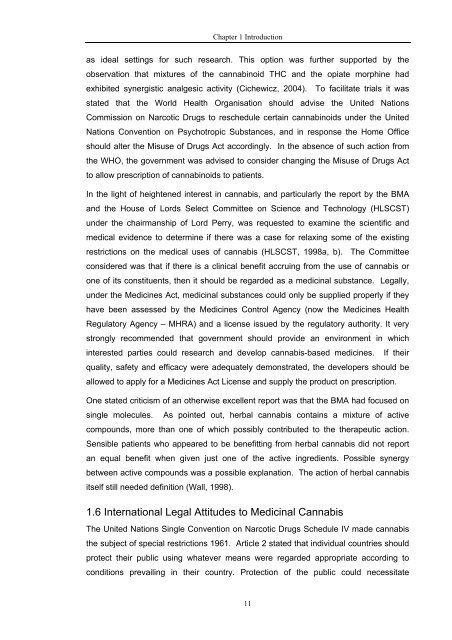finalfullthesisdjpotter
finalfullthesisdjpotter
finalfullthesisdjpotter
Create successful ePaper yourself
Turn your PDF publications into a flip-book with our unique Google optimized e-Paper software.
Chapter 1 Introduction<br />
as ideal settings for such research. This option was further supported by the<br />
observation that mixtures of the cannabinoid THC and the opiate morphine had<br />
exhibited synergistic analgesic activity (Cichewicz, 2004). To facilitate trials it was<br />
stated that the World Health Organisation should advise the United Nations<br />
Commission on Narcotic Drugs to reschedule certain cannabinoids under the United<br />
Nations Convention on Psychotropic Substances, and in response the Home Office<br />
should alter the Misuse of Drugs Act accordingly. In the absence of such action from<br />
the WHO, the government was advised to consider changing the Misuse of Drugs Act<br />
to allow prescription of cannabinoids to patients.<br />
In the light of heightened interest in cannabis, and particularly the report by the BMA<br />
and the House of Lords Select Committee on Science and Technology (HLSCST)<br />
under the chairmanship of Lord Perry, was requested to examine the scientific and<br />
medical evidence to determine if there was a case for relaxing some of the existing<br />
restrictions on the medical uses of cannabis (HLSCST, 1998a, b). The Committee<br />
considered was that if there is a clinical benefit accruing from the use of cannabis or<br />
one of its constituents, then it should be regarded as a medicinal substance. Legally,<br />
under the Medicines Act, medicinal substances could only be supplied properly if they<br />
have been assessed by the Medicines Control Agency (now the Medicines Health<br />
Regulatory Agency – MHRA) and a license issued by the regulatory authority. It very<br />
strongly recommended that government should provide an environment in which<br />
interested parties could research and develop cannabis-based medicines. If their<br />
quality, safety and efficacy were adequately demonstrated, the developers should be<br />
allowed to apply for a Medicines Act License and supply the product on prescription.<br />
One stated criticism of an otherwise excellent report was that the BMA had focused on<br />
single molecules. As pointed out, herbal cannabis contains a mixture of active<br />
compounds, more than one of which possibly contributed to the therapeutic action.<br />
Sensible patients who appeared to be benefitting from herbal cannabis did not report<br />
an equal benefit when given just one of the active ingredients. Possible synergy<br />
between active compounds was a possible explanation. The action of herbal cannabis<br />
itself still needed definition (Wall, 1998).<br />
1.6 International Legal Attitudes to Medicinal Cannabis<br />
The United Nations Single Convention on Narcotic Drugs Schedule IV made cannabis<br />
the subject of special restrictions 1961. Article 2 stated that individual countries should<br />
protect their public using whatever means were regarded appropriate according to<br />
conditions prevailing in their country. Protection of the public could necessitate<br />
11


